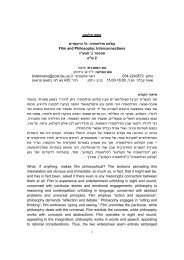The Iconography of the Temple in Northern Renaissance Art
The Iconography of the Temple in Northern Renaissance Art
The Iconography of the Temple in Northern Renaissance Art
You also want an ePaper? Increase the reach of your titles
YUMPU automatically turns print PDFs into web optimized ePapers that Google loves.
Immaculate Virg<strong>in</strong>. Her image is paralleled with <strong>the</strong> <strong>Temple</strong> <strong>of</strong> Solomon itself,<br />
which symbolises <strong>the</strong> Blessed Virg<strong>in</strong> (Tempelum Solomonis significan beatem<br />
mariam: "<strong>The</strong> <strong>Temple</strong> <strong>of</strong> Solomon signifies <strong>the</strong> Blessed Mary").<br />
<strong>The</strong> Speculum's anonymous author draws an imag<strong>in</strong>ary <strong>Temple</strong> which fits<br />
<strong>in</strong>to his metaphorical image <strong>of</strong> <strong>the</strong> Virg<strong>in</strong>. He <strong>in</strong>sists on <strong>the</strong> three p<strong>in</strong>nacles<br />
which compose <strong>the</strong> <strong>Temple</strong>'s facade decoration. <strong>The</strong>se p<strong>in</strong>nacles symbolise <strong>the</strong><br />
Triple Crown <strong>of</strong> <strong>the</strong> Virg<strong>in</strong>: Crown <strong>of</strong> Virg<strong>in</strong>ity, Crown <strong>of</strong> Martyrs and Crown<br />
<strong>of</strong> <strong>the</strong> preachers, <strong>the</strong> sa<strong>in</strong>ts and <strong>the</strong> church's doctors; for she was also a preacher,<br />
an evangelist and an apostle accord<strong>in</strong>g to <strong>the</strong> Speculum's commentary (Munich,<br />
CLM, Ms., fol. 7).<br />
In some o<strong>the</strong>r fifteenth century Speculum versions, this bizarre image is<br />
replaced by a more coherent one. In some French versions, <strong>the</strong> three p<strong>in</strong>nacles<br />
are transformed <strong>in</strong>to "iii boys" (three columns) which may echo <strong>the</strong> traditional<br />
two sacred columns: "Jach<strong>in</strong>" and "Boaz", that flanked <strong>the</strong> <strong>Temple</strong>'s doorway,<br />
but still reta<strong>in</strong> <strong>the</strong> metaphorical sense <strong>of</strong> <strong>the</strong> Virg<strong>in</strong>'s Triple Crown (Paris, B.N.<br />
Ms. Fr. 6275, fol. 6 r , 1449; Paris, B.N., Rés. 1247, fol. VIII, 1449).<br />
Moreover, <strong>the</strong> <strong>Temple</strong>, built with white marble and adorned with gold, also<br />
typifies <strong>the</strong> Virg<strong>in</strong>'s dist<strong>in</strong>guished characteristics: her Chastity and her Charity,<br />
while <strong>the</strong> spiral staircase signifies, accord<strong>in</strong>g to <strong>the</strong> Speculum's commentary,<br />
<strong>the</strong> Virg<strong>in</strong>'s Div<strong>in</strong>ity, through which <strong>the</strong> believer will be elevated to Heaven.<br />
Accord<strong>in</strong>g to this text, not only <strong>the</strong> <strong>Temple</strong> itself typifies <strong>the</strong> Blessed Virg<strong>in</strong><br />
and her Immaculate Conception. <strong>The</strong> sacred vessels <strong>in</strong>side it, <strong>the</strong> Ark <strong>of</strong> <strong>the</strong><br />
Covenant, <strong>the</strong> Candelabrum (<strong>the</strong> Menorah) are also related to her metaphorical<br />
image. <strong>The</strong> Ark <strong>of</strong> <strong>the</strong> Covenant, which conta<strong>in</strong>s both <strong>the</strong> Ten Commandments<br />
and Aaron's rod, elsewhere symbolises <strong>the</strong> Immaculate Conception, referr<strong>in</strong>g<br />
to <strong>the</strong> Virg<strong>in</strong>'s Womb filled by <strong>the</strong> Div<strong>in</strong>ity, while <strong>the</strong> Candelabrum, resplendent<br />
with light, prefigures <strong>the</strong> Virg<strong>in</strong>'s Chastity (Sa<strong>in</strong>t-Omer, BM, Ms. 184, fol 9 v ;<br />
Paris, BN fr. 6275, fol. 12 r ). Sometimes <strong>the</strong> seven branches <strong>of</strong> <strong>the</strong> candelabrum<br />
are compared to <strong>the</strong> Seven Works <strong>of</strong> Misericorde which are also related to <strong>the</strong><br />
Virg<strong>in</strong> (Lutz and Perdrizet, II, 130).<br />
Jan Van Eyck's Ypres Altarpiece (Warwick Castle, ca. 1441, f<strong>in</strong>ished after<br />
<strong>the</strong> artist's death) shows some aff<strong>in</strong>ities with <strong>the</strong> Speculum tradition. <strong>The</strong> <strong>in</strong>ner<br />
section <strong>of</strong> <strong>the</strong> w<strong>in</strong>gs conta<strong>in</strong>s some mariological metaphors related to <strong>the</strong><br />
Immaculate Conception: <strong>the</strong> Burn<strong>in</strong>g Bush and <strong>the</strong> Golden Fleece on <strong>the</strong> left<br />
w<strong>in</strong>g and <strong>the</strong> Closed Gate and Aaron's Rod, on <strong>the</strong> right. This image is<br />
completed with an <strong>in</strong>scription that relates <strong>the</strong> <strong>Temple</strong>'s symbolic mean<strong>in</strong>g to<br />
<strong>the</strong> Virg<strong>in</strong>'s Immaculate Conception: Conditoris tempelum sancti spiritus sacrium<br />
("She is <strong>the</strong> <strong>Temple</strong> <strong>of</strong> <strong>the</strong> builder, <strong>the</strong> Sanctuary <strong>of</strong> <strong>the</strong> Holy Spirit" as Cited <strong>in</strong><br />
Meiss, 'Light as Form and Symbol <strong>in</strong> some fifteenth century pa<strong>in</strong>t<strong>in</strong>gs', <strong>Art</strong><br />
166
















